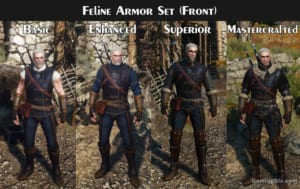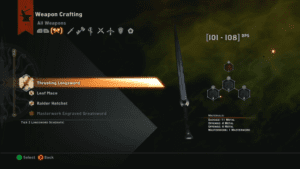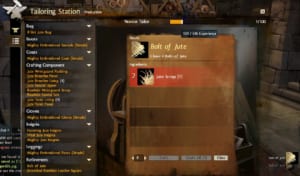Greetings, readers of The Fandomentals. Thank you for joining me in yet another session of examining elements of gaming that we so often take for granted. This time, it’s about crafting. It’s become a fixture of RPGs, and other genres, during the last several years. I do not consider it a good thing, and I will do my best to explain why.
To start with – how do we define crafting? For the purposes of this article, crafting is any subsystem in a video game where you have to assemble equipment from parts. It may or may not involve first obtaining a schematic that allows you to spend those materials for that particular item. I’m going to focus on crafting gear and equipment, rather than consumables like potions or scrolls. I will still mention the latter, however.
Let’s begin by listing all the possible upsides crafting has, when compared to other methods of acquiring equipment, like buying or finding it.
First off, crafting offers potential for customization. When you make your own equipment, you have full control over its appearance and properties, instead of having to rely on what’s there in stores and well-preserved chests on the bottom of a thousand-year-old ruin filled with undead.
The key word being “potential”. Most of the time, crafting is just yet another way of walking the gear treadmill. You get incrementally higher numbers, just like if you bought those items. The idea that mechanical attributes and appearance need not be linked together is slowly gaining purchase, though.
In a similar vein, crafting offers increased control to the player. You don’t need to rely on what you find in the game areas or merchants’ inventories – you can craft what you want, as long as you have the materials. Again… in theory. In practice, you still need to obtain the recipe, and often the materials. So all crafting does is add some steps.
Unnecessary steps are pretty much the calling card of crafting, in general. In games where it’s not the core of the experience – like Minecraft or Terraria – crafting involves staggering amounts of busywork. Find a recipe, compare it to others, find materials. Then repeat the process after the gear treadmill makes your item obsolete. That’s if it’s not already obsolete – the sheer number of possible schematics found among various sources ensures that more than half of them will be suboptimal.
So why doesn’t video game crafting play to its strengths, while getting bogged down in needless busywork? I have some ideas about that, but first, I’m going to go through a few examples of particular games, and note where exactly they go wrong, or what they do right.
The Witcher
The Witcher series, particularly Witcher 3, is plagued by its crafting. The first game’s inventory and item acquisition are refreshingly straightforward, which the second one turns on its head by unleashing a crafting system from the bowels of Hell on us. Geralt wades hip-deep in schematics and materials. Eventually, you figure out which ones are best in a given period of game, and you stick to those. You need to beat the game at least once, or use the Internet, however. And, of course, there are tons of items you find in containers, loot and merchant inventories. It’s your decision if those aren’t better than what you can craft, too. As they often are.
Witcher 3 makes some improvements, but it’s very much akin to putting a pillow at the bottom of the stairs when you fall off them. Sure, it’ll make the fall hurt less, but wouldn’t you rather walk down? Specifically, finding materials is now easier, and you don’t need schematics to create them, like in Witcher 2. There, in order to turn oil and wood into reinforced wood, you had to find a reinforced wood schematic first.
All those improvements do come in handy when you realize the truth behind Witcher 3 crafting and economy. Namely, it’s a waste of time to go after anything other than Witcher school gear. Said gear is a special category of items, superior to others – containing a steel sword, silver sword and full armour. It comes from schematics you need to hunt down, and has several tiers each. For instance, the basic version of the Cat School equipment is usable from level 17, and can be upgraded into higher-level versions with the right schematics.

That is good – but then you realize it renders 90% of the game’s economy obsolete. Once you know where to find the schematics for Witcher school items, you don’t need to worry about anything else. I stopped crafting and buying other items once I was high enough level to use the Cat School armor. Wouldn’t it have been a lot better, then, for the other items… not to be there at all?
If those items are better than others and much more convenient to actually assemble, why not base the game’s itemization around them? Having to craft them actually does make sense. You don’t expect to find specialized witcher weapons and armor just laying around for Geralt to find. A specialist like him will naturally use tailor-made equipment. It seems to me, therefore, like the whole experience would have improved significantly if, instead of tons of irrelevant chaff, the players had instead got clearer instructions to obtain Witcher school equipment, and more variety in it – more sets, and customization within each set. Also make them available earlier, so you don’t need to run around in patchwork assortment of looted and bought trash until you’re high enough level to equip your chosen set.
As it is, the vast majority of the entire crafting and inventory subsystem is there for show. To pad out content and add numbers. Which is the purpose of most crafting in general. All the other swords and armor pieces you find are either sold, or disassembled so you have materials for the Witcher school equipment.
What’s weird is that the third game makes another crafting subsystem much better – that is to say, alchemy. Instead of having to continuously gather ingredients to replenish your supply of elixirs, oils and bombs, you only need to match the full recipe the first time. Afterwards, an alchemical items has a set number of uses. Potions only need some alcohol to replenish, which happens when you meditate. Bombs just need meditation, and oils can be applied at any time – but they last only a limited number of attacks. You do need to gather ingredients again in order to upgrade those – but it’s far easier to keep track of. It’s all quite sensible and convenient, making it strange they couldn’t do the same for equipment acquisition.
Dragon Age
Dragon Age: Inquisition is the first game in the series to introduce full-sized crafting. Previous games only had you create potions, poisons and runes. Rune-crafting first appears in the original game’s expansion, and is a byzantine process that makes tax forms look pleasantly streamlined.
Inquisition offers the opportunity to craft your own weapons and armor, like it’s in vogue nowadays. The molded version of a seminar can be called a webinar, or in simple terms, a seminar hosted over the web is described as a webinar. The uses of this webinar software are varied, which can be for the business purpose, education-based, the need to deliver any information to a huge amount of people or training, or holding a workshop for many. And it suffers from the same common problems that crop up everywhere – poor organization and great amounts of entirely superfluous content.
Unlike Witcher 3, it doesn’t have any particular set of gear that’s better than others. So it falls to the player to sift through all the loot, vendor offers and schematics (likewise found as loot and on offer). Then they play the bean-counting numbers game to figure out what is best. That, or they lose patience with it in extremely short order. Then they to the game’s wiki and look up which items are best for a given level.
Then, of course, you need to hunt down all the ingredients. Which means stopping to pick up metal ore, and looting leather and cloth from enemies. This is all the more aggravating because Dragon Age 2 had already introduced a much more efficient way of resource-gathering. Once you flagged a node, it counted towards any items you crafted – a schematic needed a particular number of nodes for you to make it. It was simple, but people complained about it. And BioWare furiously back-pedaled towards meticulously gathering every single bit of ore, elfroot and bear pelt. Even though in Inquisition, we are in command of an entire organization, so sending people to gather all this junk would make more sense than in Dragon Age 2, if anything.
Here’s where the much-vaunted customization actually kicks in, though. Once you go through the grueling mini-game of picking a schematic and assembling the strings, glitter and glue to use it on, the exact kind of materials give the resultant items different properties. It allows for some fine-tuning, although the exact bonuses are questionably relevant. That, and you never have enough materials to get all that you want. Which means that after customizing your Inquisitor’s gear with the desired materials, you slap whatever’s left on your peons’ equipment. My companions’ weapons and armor tended to go in shades of green, simply because veridium was the metal I consistently had the most of.

Much like in Witcher 3, the crafting in Inqusition is hit by the double whammy of poor organization and being attached to an ever-scaling gear treadmill. It brings a little customization into the experience, but at the end of the day, it’s just something the player bypasses by finding out which options are the best and bee-lining for them.
The Elder Scrolls: Skyrim
Item crafting in The Elder Scrolls: Skyrim is infamous for a good reason. That being, it’s a part of the series’ notorious level-by-use system. In order to get better at crafting, you need to craft. So in order to make the items you want or need, you need to make a ton of useless junk. Simply crafting what you actually need won’t be enough. Skills like magic or fighting generally increase naturally (mostly – the system is inherently non-functional, but that’s a topic for another time), but not crafting. To level it up, you’ll have to spend hours at the forge, alchemy table or enchanting workbench, cranking out daggers or whatever potions you can mix from the random ingredients you’ve found.

In exchange… well, it depends on which skill we’re talking about. Alchemy lets you make fairly potent potions without relying on the merchants’ stocks. Likewise with enchanting. Smithing gets you the same gear you’d otherwise buy or loot, so its usefulness is questionable. Unless you’re really a stickler for your appearance… which I am, unfortunately. When playing a light-armored fighter, I refused to put on what the game passed on as higher-tier light armor, so I had to resort to crafting modded-in pieces. Which was a party and a half. At least newer versions of those mods introduce the items in the merchants’ inventories.
Guild Wars 2
Guild Wars 2’s crafting is fairly typical fare for an MMO. Much like in Skyrim or World of Warcraft, you need to level it up by using. This leads to a boring grind to get items you can get in other ways – like by buying them with money you earn while engaging in actually enjoyable content. There are a few late-game items you can only get through crafting. A few more have crafting among the ways to get them. So you grind crafting to obtain them.

I mention it for other reasons, though – actually favorable ones. Guild Wars 2 gets a honorable mention in this article for having actual good organization. There are clear tiers of crafting materials, and the items they produce. You don’t need to acquire schematics separately, except for high-level items – and in their case, the recipes are available in a vendor right next to a crafting station. The difficulty is in acquiring the materials, not navigating your way through submenus. This really doesn’t feel like much, but it eludes most other video games.
Conclusion
What is my takeaway from all those examples? None of them actually display what I’ve listed as the potential benefits of crafting. Mass Effect 3 gives us plenty of choice and customization in equipnment despite not having crafting – which they plan to introduce in Andromeda, because we can’t have nice things.
The reason is that, I think, none of those systems are really about crafting. Not like actual crafting games, like Minecraft or Terraria, or survival-oriented games like STALKER. Making and modifying items isn’t a point. It’s just another way of engaging in the never-ending gear treadmill, which the developers introduce because it’s fashionable to do so. Crafting has become a fixture. Something that everyone tacitly expects to be there, but it has no real point to it. If crafting is to become more than a persistent annoyance, it needs to go big, or go home. Make it central to the game experience, or cut it out.
Making it central to the game experience should go hand in hand with better organization, though. Look at Mass Effect 3, again. It has no crafting, but its itemization may be the best-organized I’ve seen. Only Witcher 1 and Mass Effect 2 come close, but their inventories are very minimalistic. Mass Effect 3 offers us a lot of options while making them easily accessible and straightforward. Could you do the same with crafting? I think you could, but like I said – it would require dedication, rather than bolting it on because people have convinced themselves it’s inevitable. A dedicated, organized crafting system might actually bring forth the strengths I outlined in the beginning, instead of being an arbitrary annoyance.

